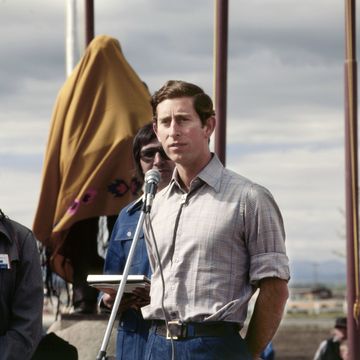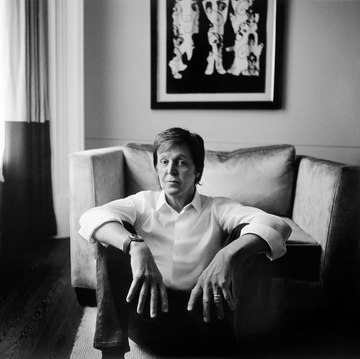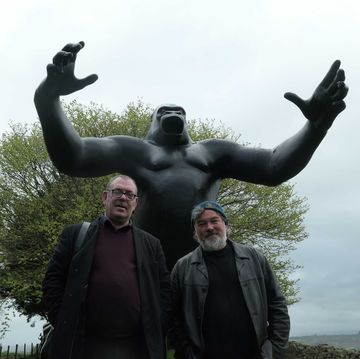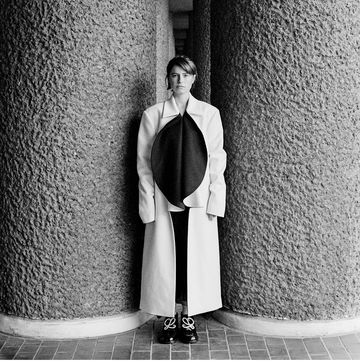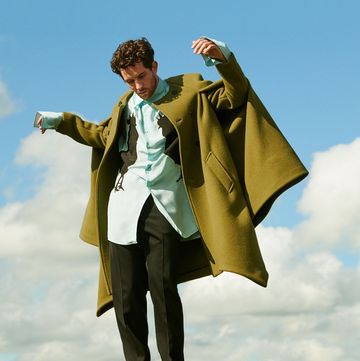You know you are living through an emergency when you can't stop talking about leaders. Like the efforts of good parents, politicians' actions should mainly be invisible, only requiring constant scrutiny when something is wrong. We grew up thinking that progress and populism were tied together and that liberal values became the natural order. But it seems we were wrong: we are in a Hobbesian state of nature, where the life of man is "nasty, brutish and short", where British politicians go against their principles to stay in power. When egotistical men and women create a revolution in manners and call it freedom, you begin to look away.
Fashion, of all islands, might seem an odd place to establish your moorings, yet let it be said that freshness and tolerance have always been possible goals in the world of fashion. It can dare you to be otherwise, and that is one of the reasons I love it. The bonkers-ness is addictive, the sense of beauty is ripe, the avant-garde is still alive, and taste is a kind of circus. It might be good for us, on another day dominated by the machinations of pathological liars, to go in search of some beautiful craft and a love of ideas, and to take her out for the day and kiss the ground she walks on.
Grace Wales Bonner is 26 and was raised in South East London. She is one of five children born to an English mother and a Jamaican father. Graduating from Central St Martins in 2014, she immediately expressed an obsession with "rhythmicality" in music and art, and the fashion industry was poised to take notice of her first designs. She won the L'Oreal Professionnel Talent Award and immediately saw herself, as she said later, "subverting both constructs of masculinity and the hallmarks of privilege that define European luxury fashion." Her menswear label, Wales Bonner, launched during London Fashion Week Men's in 2015. Tall, thin, black guys came down the catwalk looking as if Coco Chanel had come back ebony and sexually fluid. A touch of Harlem renaissance blended with Seventies "blaxploitation" and a sense of the British council estate.
Only three months after that first Fashion Week appearance, Bonner showed at the V&A in its "Fashion in Motion" event. Men in glitter, basically, with big Swarovski jewellery, sports tops and pinstriped denim. Against a big Orientalist sunset, her menswear collection was polymorphous, glamorous and effortlessly upsetting of gender and racial stereotypes. Blue glitter fists were raised in the Black Power salute. Gimme more, said everybody. She won the category of Emerging Menswear Designer of the Year at the British Fashion Awards in November 2015.
People are clambering to own her stuff, yet the pieces always feel a little one-off. It will be interesting to see how long she can sustain this before mass production and the big fashion houses descend on her. The New York Times loved her designs for AW '17: "Ms Wales Bonner's catwalk served as a lyrical tribute to the perhaps-fading notion of a cosmopolitan Britain." She is enjoying one of the fastest rises of a designer in recent memory. I predict an avalanche of interest in Grace Wales Bonner: the coolest designer in Britain.
At the end of the day in London Fields, Wales Bonner showed me her office and smiled at the future. "It's kind of low-key," she said of her building, which was opened by a member of Radiohead as a creative hub. She was beginning to think about her new collection and there is only one photograph on the mood board: a shot from the Korean artist Yun Hyong-keun's recent show at the Zwirner Gallery in New York. Wales Bonner's office is narrow and has a single computer and a bottle of water. It was amazing to see her there, right on the cusp.
I told her she'll look back with wonder on the great freedom and promise of this office. She agreed. She's trying to enjoy the moment before it all disappears. "I want to show you my favourite thing I made," she said, pulling some brown checked leather trousers off a rack. She sounds like the sweetest, youngest and most guileless person in the known world. "It's made from scraps of leather, cut into a harlequin pattern, and hand-glued together between a layer of hard leather, made by Chapal, a family-owned leather atelier that has specialised in this craft since 1832. I love to find people who can still make handmade craft like this."
On her computer, she keeps a scrapbook of what she calls street characters. It's the sort of thing a novelist might do, and the characters intersect with her life, her sense of politics, her love of certain looks and new ideas of nobility. From a shelf containing José Munoz's Cruising Utopia: the Then and There of Queer Futurity, a DVD of Isaac Julien's Young Soul Rebels (1991), and a copy of Zadie Smith's new novel, she took down an art book about the Cameroonian photographer Samuel Fosso, a man who fled the war in Nigeria at a young age and set up his own photography studio in the Central African Republic. Wales Bonner showed me through the book and then her eyes rested on her rail of clothes.
"The last collection was really about characters," she said. "There was like four different characters: one of them was a Caribbean soul brother; then there was this spiritual character who always wears white. Thirdly, a more intellectual one and the final one was a Renaissance-inspired, effeminate son." She tells me she has an ambition to elevate the street, to choreograph the looks that people might have, and this means she won't take anything for granted about men and who they're supposed to be.
That's good news for the readers of Esquire, I said.
Earlier that day, I'd met Wales Bonner at Tate Britain. I'd wanted to bring her somewhere that would stir her into natural conversation. Most fashion interviews are boring. There are reasons for this — designers don't think in words, they are anxious to promote their brands, fashion writers are too often kept to hemlines and deadlines — and we all struggle to enter the fashion ether without becoming intoxicated by it.
Wales Bonner landed at Tate Britain like a visiting sparrow — sleek and beautiful, small-boned and beady-eyed. She wore a Prada coat and a skirt by Chloé and her smile said, "You're funny." Walking through the halls of pre-Raphaelites and the English Vorticists and Impressionists, we stopped at the famous Henry Wallis painting of Chatterton, the quintessential, young, beautiful, dead artist, his work in tatters around him. "I love this painting," Wales Bonner said. "My dad used to show it to me. He loved it."
"Black Diaspora in London, 1960–1970" was a display of the photographic work of eight photographers documenting West Africans and West Indians during those years. "Stan firm inna Inglan", from a poem by Linton Kwesi Johnson, was the rubric of the show, welcoming these iconic photographs into the Tate collection. Wales Bonner had just come off a flight from New York and was tired but her eyes widened when she saw the photographs. We walked to one by Bandele "Tex" Ajetunmobi of a Fifties couple, a black man and a white woman drinking beer in a Whitechapel members' club. "It reminds me of Kerry James Marshall's painting," she said. "Like having a couple, a black couple in his case, in a casual and romantic setting."
Is it alive to you in a political way?
"I have an emotional reaction to it," she said. "Even if it's subconscious, I feel there's a residue of politics and of that particular time and I carry the history of it somehow. For my work, I tend to think of a cast of characters. For instance, I like to think of a certain kind of man who is more expressive than usual — say, a dancer or a composer — who has more licence to be performative."
Another of Tex Ajetunmobi's photographs in front of us showed a man at a piano. It looked to be the same East End social club as before; the man had clearly had a bit of a night of it; he had spilled drink over himself and he was lost perhaps in the music.
"It looks like he's playing within a framework that is already established," she said. "I'm interested in jazz and looking at how it introduced African polyrhythms into classical scores, that's how it works: it's about making space for new forms within structures that already exist. That's how I position myself."
OK, I said, so, when it comes to menswear, we think we know. There's Savile Row over there, there's tailoring. There's the whole western tradition of male elegance. Dressing for war. Dressing for industry. Dressing for the gentlemen's club.
"Right," she said. "And I'm interested in there being so much history. But it feels for me a space to play in and to 'vibrate' in."
So you're not offended by those traditions?
"No. I just wonder how I fit in."
Journalist and author Gary Younge said the photographs transform black Britons "from objects to subjects, from recipients of hospitality to cultural agents". I ask Wales Bonner if she agreed. "Yes, I think so. It's a turning point when you turn the camera on yourself. I love that moment where we take responsibility for our own representation."
Many of the images come from a point in history that detains her as a designer, the Seventies. She loves the clothes of that time. The ethos. The playing with gender. "That's where I got started," she told me.
Wales Bonner turned eagerly to the photographs of Colin Jones. "These remind me of my dad's family," she said. Taken between 1973–'76, the photos are part of a series called "The Black House", documenting life on a housing project funded by Islington Council. A group of guys are lined up against a wall, each exhibiting a look of his own.
"I definitely looked at these," Wales Bonner said. "It's like the house and the garden in Stockwell where my father grew up. So familiar. They speak to me." She pointed to a picture of a few families gathered in a garden. "My childhood was very like that and I have an almost romantic memory of those things being real, the aunties being around. So informative. The clothes aren't that special, in a way, it's the way they wear them. Those guys. It's personal style. But it's like a simulation of something that exists."
That's an economic thing.
"Yes. And with design now, I want to show how to execute those ideas at a different level. I want it to be coming from that black cultural perspective but then considered at the same level as any other kind of luxury or European brand. That's the ambition. Because there isn't a luxury designer that I can think of who draws on these exact influences and raises it all the way. There's an ease and a comfortableness and an emotion I aim to have in the clothes."
Last year, Grace Wales Bonner won the LVMH Prize, which gave her €300,000 and a year's worth of mentoring from top fashion executives. She is happy for the help but there is something incorruptible about her. She admits fashion items are expensive but believes there is no reason why black men should seek luxury on the cheap. It's a costly business, and it's part of her point that white men have no monopoly on quality.
We lit on a group of photographs by Al Vandenberg. They are based around the Notting Hill Carnival, as one of Wales Bonner's last collections was, and we paused to pore over a photo of Portobello Road thronged with summer revellers, the sound system almost vibrating into the room. "I love the way sound can transform a street space," she said. "There's a moment in Ralph Ellison's novel Invisible Man, where the main character sees an old couple being evicted, and, suddenly, he is finding his voice and his voice is transforming the environment."
And that's what you want to do?
"Yes. The last collection was about elevating street life and culture and relating it to other strands of history." She homed in on a photo of two girls dressed to the nines. "Do you think they're sisters?" she asked.
We stood there for ages. Anybody who has lived in London would recognise the fraternal joy in those images of Notting Hill. It's the real London, not this scarred landscape of racial paranoia and closed borders and Ukip ugliness. It's the beauty of people opening up their culture to other people, of sharing a space. I asked Wales Bonner if she worried that that kind of cosmopolitan England was coming to an end.
"I feel like I've tried to explore that idea in terms of how important it is. I looked at my grandparents who came to England as part of the 'Windrush Generation' from Jamaica, and I wanted to celebrate that kind of collision of cultures, the energy of being in the London streets, where it all comes together. My show was political in the way it tried to animate the beauty of the old contradictions."
Wales Bonner feels that fashion can be part of a global dialogue that doesn't accept small definitions of belonging. I take it away from our day as the vital and optimistic message of a brilliant young woman.
"There's a web of people all over the world who just don't connect with current politics or definitions of place. It might feel like a physical thing to be stuck within your own borders, but, actually, there's an ideological network of people, for sure, who have strong energy and connectivity that transcends that, people in my generation from all over the world, who are much more of a community, and much more hopeful, who have a sense of urgency to do what they're doing in an honest way, who will be braver now."
It's all in the clothes, and around the clothes, and in the spaces between. Grace Wales Bonner might be a forwarding scout for the post-jingoistic world, pray that it comes, where nations are never stronger than the people who traverse them, where otherness and opportunity go together, and where nobody is simply one thing. Back at Wales Bonner's studio, we drank some tea before I prepared to leave. I asked her, where would you like to be in 10 years' time?
"I'd love to have an established brand," she said. "One that people can interact with on all different levels. And to have a strong business behind what I do."
Would you sell to a major brand?
"I'd like to learn from them. But no. Wales Bonner has to be independent." Something both steely and hopeful appeared to take over her tiny frame. I hope so, I said.
As we walked down the stairs, you could hear the echo of music coming from hopeful bands in the workshops along her corridor. I went ahead and reached the street where London Fields was beginning another night. Grace Wales Bonner's footfalls were behind me and they already felt like echoes from her own past. "I hope so, too," she said.
Portrait by Jamie Morgan at Serlin Associates



